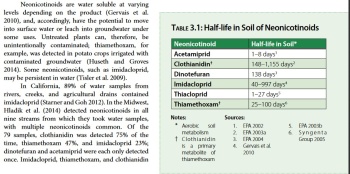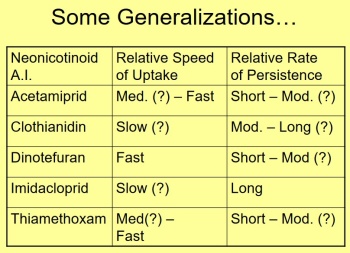Some information, and differences on two Neonicotinoids, used to treat grapes for sucking insects, some chewing insects and soil insects.
Another factor is half life in the soil. Acetamiprid is 1 - 8 days and Imidacloprid is 40 - 997 days.

http://ento.psu.edu/publications/are-neonicotinoids-killing-bees
And:

http://webdoc.agsci.colostate.edu/bspm/Garden Center Talk July 2014.pdf
Some additional articles:
Insecticides used in greenhouse and landscapes and toxicity to pollinators
Study Finds Glyphosate and Acetamiprid to Have Relatively Low Toxicity for Honey Bees
Of note: There appears to be an effort underway to get certain neonicotinoid products banned. In CA alone (2012):
It appears that Acetamiprid might be a viable alternative, with less lethality to bee colonies and a shorter half life in the soil, to the widely used and effective Imidacloprid. Some potential options currently labeled for use with grapes:
Assail (30 & 70% available)
Ortho® Flower, Fruit & Vegetable Insect Killer Concentrate (0.5% available)
http://www.beyondpesticides.org/pro...llinators-and-pesticides/chemicals-implicatedNeonicotinoids are a relatively new class of insecticides that share a common mode of action that affect the central nervous system of insects...They include imidacloprid, acetamiprid, clothianidin, dinotefuran, nithiazine, thiacloprid and thiamethoxam.
1. Imidacloprid
Used in agriculture as foliar and seed treatments, for indoor and outdoor insect control, home gardening and pet products, imidacloprid is the most popular neonicotinoid, first registered in 1994 under the trade names Merit®, Admire®, AdvantageTM. It is moderately toxic and is linked to neurotoxic, reproductive and mutagenic effects. It has been found to be highly toxic to bees and other beneficial insects. It is also toxic to upland game birds, is generally persistent in soils and can leach to groundwater.
3. Acetamiprid
Acetamiprid has population-level effects on honeybees even though it has low acute toxicity. Certain neonicotinoids interfere with honeybee reproduction, ability to navigate, or temperature regulation, any of which can have an effect on long-term survival of honeybee colonies.
Another factor is half life in the soil. Acetamiprid is 1 - 8 days and Imidacloprid is 40 - 997 days.

http://ento.psu.edu/publications/are-neonicotinoids-killing-bees
And:

http://webdoc.agsci.colostate.edu/bspm/Garden Center Talk July 2014.pdf
Some additional articles:
Insecticides used in greenhouse and landscapes and toxicity to pollinators
Study Finds Glyphosate and Acetamiprid to Have Relatively Low Toxicity for Honey Bees
Of note: There appears to be an effort underway to get certain neonicotinoid products banned. In CA alone (2012):
https://www.winesandvines.com/news/article/100138/Winegrape-Pesticide-Facing-Greater-ScrutinyThe resolution urges “the United States Environmental Protection Agency (USEPA) and the California Department of Pesticide Regulation to act expeditiously to protect pollinators, especially honeybees, by prohibiting the use, marketing, or sale of neonicotinoid products deemed hazardous to pollinators.”The resolution specifically lists neonicotinoid products containing imidacloprid, clothianidin, and thiamethoxam, as being highly toxic to honey bees.
...
Alternatives Limited for Now
Pesticides other than imidacloprid have been used for GWSS control, however, some of the most effective alternatives are also neonicotinoids.
It appears that Acetamiprid might be a viable alternative, with less lethality to bee colonies and a shorter half life in the soil, to the widely used and effective Imidacloprid. Some potential options currently labeled for use with grapes:
Assail (30 & 70% available)
Ortho® Flower, Fruit & Vegetable Insect Killer Concentrate (0.5% available)





